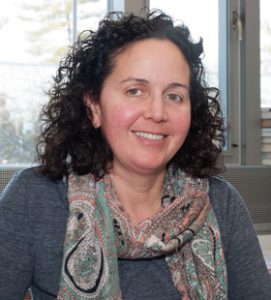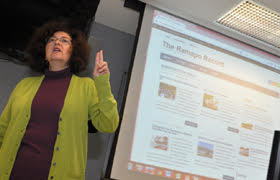- About Ramapo
- Academics
- Admissions & Aid
- Student Life
- Athletics
- Alumni
- Arts & Community
- Quick Links
- Apply
- Visit
- Give
Instructional Design Center
February 12, 2018Program Profile: Nursing Goes High-Tech
For nearly two decades, the Nursing Program at Ramapo College has been developing high-tech strategies to prepare students to become the best nurses in the field. The Nursing Program was the first on campus to begin teaching online in 1999. “We were responding to the needs of our students and the demands of the field,” says Kathy Burke, Assistant Dean of Nursing Programs.
Those early days of online learning paved the way for a comprehensive online and hybrid approach that has influenced the nursing profession around the world. Ramapo has established a partnership with Kwame Nkrumah University of Science & Technology in Ghana. Nursing students and faculty travel to Africa for three weeks to explore the global issues of public health. Technology helps the Ramapo and KNUST partners communicate and plan during the year. Ramapo Nursing faculty also teach some of the courses in Africa via virtual platforms.
The most impressive technological advances in Nursing are evident in the Adler Nursing building, which contains a state-of-the-art simulation lab called Ramapo Hospital. This sim lab is run by Joan Richards, Simulation Director; Debi Nickles, Simulation Coordinator; Kathleen Farina and clinical instructors. The three simulation bays look exactly like hospital rooms. Each has a simulation high fidelity mannequin (referred to as “patients”) in high-tech interactive rooms that include hospital beds, computers, and other standard hospital equipment. Simulations are integrated every semester; they get more complex as students move through the Nursing program, culminating with a Senior Capstone simulation.
The simulation instructors work from the control room, sending simulated medical events via computer. The control room is hidden behind a one-way glass mirror across from the hospital room. The control room contains live video and audio feed of the hospital room, as well as the simulation computer/software. The patient’s vital statistics beep and display live on a screen. In one simulation the patient had been shot in the chest and had just been transferred to the unit. As Joan Richards initiated medical events on the computer, such as trouble breathing, the students responded in their hospital room. They asked the patient questions, listened with their stethoscope, gave breathing treatments, and took vitals. The students entered data into the patient’s chart, administered medication, called the doctor, and more.
Once the hour-long simulation is finished, the students enter the debriefing room and with the instructors reflect on the simulation to analyze the simulation. The debrief closes the loop on the learning experience for everyone. Joan says there is a level of buy-in required by students when first exposed to the simulation lab, but once they cross that threshold they want more. Ramapo’s Nursing students are gaining valuable hands-on experience, learning to think under stress, reflect on real-life experiences in the hospital, and become better equipped to respond to the challenges they will experience every day as nurses. The simulation lab, and all the technology embraced by the Nursing program, gives Ramapo students a unique level of experiential learning that will undoubtedly enhance their careers in nursing.
Categories: Uncategorized
February 12, 2018Sharing Tips for G Suite: Docs, Sheets, Slides and Drive

Sharing of documents and folders makes collaborating easy. However, you want to be sure you set your share permissions properly. By default, all documents and folders are private. Click the blue Share button to share with any faculty, staff or students at Ramapo. You cannot share documents or folders outside of the ramapo.edu domain. After you click the share button, you have the following options:
To share only with specific individuals:
- Enter the name or email address of specific individuals whom you wish to share
- Click the pencil icon next to each individual’s name to set their level of access. Choices include “can edit,” “can comment” or “can view”
- See advanced Share settings below for further important permissions
Get Shareable Link — To share with anyone at Ramapo College:
Use this feature cautiously, so as not to share beyond your intended audience.
- Click “Get Shareable Link” to copy the link and turn link sharing on
- Select from the following drop down options to set the level of access:
-
- Anyone at Ramapo College with the link can view
- Anyone at Ramapo College with the link can comment
- Anyone at Ramapo College with the link can edit
- Off – only specific people can access (choose this if you accidentally selected “get shareable link”)
- See advanced Share settings below for further important permissions
Advanced Share Settings:
- Click “Advanced” to choose the following options, after clicking the blue Share button:
-
- Prevent editors from changing access and adding new people
- Disable options to download, print, and copy for commenters and viewers
- To change any of the settings mentioned above, or to remove an individual’s access
Categories: Uncategorized
February 12, 2018New Resource Exploration: Turning Videos into Interactive Lessons
Videos are great tools for the classroom. But how do you know that students are understanding the video content? How do you know that students are even watching the videos you assign at all? There are some great (and free!) tools that enable you to add questions, include commentary, and track student understanding of the videos.
Edpuzzle – www.edpuzzle.com: Edpuzzle enables you to work with already existing videos from YouTube, Khan Academy, or upload your own. You can add multiple-choice or open-ended questions wherever you decide you want the video to pause. Through the dashboard you will know if your students are watching your videos, how many times per section, and if they’re understanding the content.
Playposit – www.playposit.com: Another free tool, Playposit features an editing platform that allows anyone to easily enrich video (from anywhere on the web) with a variety of powerful interactions. Learners receive live feedback to increase long-term retention, which triples learning efficacy over standard video, according to research cited by Playposit.
Check out these easy-to-use tools to step up your video-based lessons and instruction!
Categories: Uncategorized
September 22, 2017Faculty Profile — Cathy Moran Hajo

When you enter Professor Cathy Moran Hajo’s office in A-wing, you enter the heart of the Jane Addams Papers Project at Ramapo. She is surrounded by a team of history students who analyze, transcribe, and digitize both typed and handwritten correspondence to and from Jane Addams, notable figure of the Progressive movement and advocate for social justice. This project is one example of how Professor Hajo involves students in historical research through technological tools.
Professor Hajo believes it is important for her students to leave college with expertise in a variety of technologies in order to research, investigate, and analyze information and data. This connection to technology has always been a constant in her approach to teaching and scholarship. Even though the tools have changed over time and will continue to change, she believes it is important for college professors to stay current.
WordPress is one of the main technologies that Professor Hajo employs with her students. The students use WordPress to create websites of their historical research, enabling the students to reach a local and global community with their findings. She also uses Omeka, the platform that powers the Jane Addams Papers, to help students analyze documents and exhibit their findings with an online community of historians. She uses HistoryPin, mapping software that enables students to tag points on a map with historical facts and data. Basecamp is yet another technology employed by Professor Hajo; this project management tool helps students take ownership of their work in group projects.
Professor Hajo has a number of fascinating projects in the works. Notably, she received a COPLAC grant to deliver an online, team-taught course on the subject of censorship. This spring she will partner with Professor Rebecca Dierking at Truman State University to lead online synchronous class sessions with students. The students will conduct independent research on local issues related to censorship and produce WordPress sites highlighting what they discovered.
Recognizing a range of technological expertise among faculty, Professor Hajo has some sage advice: “Don’t be afraid to try a new technology in class by asking your students to discover the tool along with you. This can be a great experience for students and faculty alike.” She also advises taking advantage of the many professional development opportunities available. For the humanities in particular, Professor Hajo recommends the Digital Humanities Summer Institute. This is one resource that has helped Professor Hajo hone her wide range of skills with bringing technology into the classroom.
Categories: Uncategorized
February 13, 2017Faculty Profile – Lysandra Perez-Strumolo: Embracing the Online Teaching Experience

Lysandra Perez-Strumolo, Associate Professor of Psychology, once thought of technology purely as a distraction and impediment to student engagement. Yet as she began to incorporate some technological tools she discovered some unexpected ways in which technology could bolster her instruction. Now Professor Perez-Strumolo incorporates a range of technologies. She relies on Moodle discussion forums to present problem-based questions that students answer both individually and in teams. She uses Qualtrics, a survey building tool, to help students evaluate each other’s presentations; the students use their mobile phones to provide the presenter with immediate feedback. Another important technology for her is Adobe Connect, which she uses to conduct online office hours. “I use technology in a very intentional way and only if it furthers the students’ learning,” says Professor Perez-Strumolo.
As with technology in general, Professor Perez-Strumolo has experienced a dramatic change in opinion related to online courses. She once viewed online education as far inferior to the traditional classroom experience. Now she recognizes that they are different modalities of education, each presenting advantages and disadvantages. She says, “There are certain things you can do better in the online environment, and there are certain things you lose.” The opportunity for more comprehensive feedback is one of the gains that Professor Perez-Strumolo sees in online courses. However, she feels that we lose the interpersonal connections that we so value in face-to-face settings, a factor that she is aiming to mitigate through collaborative assignments, peer feedback, and discussion forums.
Professor Perez-Strumolo has some excellent advice for those beginning to teach online and integrate technology into their instruction. “Talk to other instructors and look at other course designs as much as possible.” She also recommends reading up on instructional methods and strategies. Here are some of her recommendations:
Engaging Ideas: The Professor’s Guide to Integrating Writing, Critical Thinking, and Active Learning in the Classroom by John C. Bean (2011)
Student Engagement Techniques: A Handbook for College Faculty by Elizabeth Barkley (2009)
Building Online Learning Communities: Effective Strategies for the Virtual Classroom by Rena Palloff and Keith Pratt (2007)
Categories: Uncategorized
October 20, 2016Google Apps Suite
Your Ramapo Gmail account gives you much more than access to email. While logged into Gmail, click on the Apps icon at the top right of your screen. There you will see all the features available to you, including:
- Drive: Great for file storage, sharing documents, and collaborative writing projects
- Docs, Sheets, and Slides: Where you can create and share text docs, spreadsheets, and presentations
- Sites: Build websites for your class or have your students create and share original websites
- Maps: Ideal for any project that involves mapping and geography
- Hangouts: Enables text-based and video-based chats with colleagues and students
- Forms: Can be used for surveys, quizzes, and other kinds of evaluations
Categories: Uncategorized
October 20, 2016Faculty Profile – Thierry Rakotobe-Joel

The students in Professor Thierry Rakotobe-Joel’s business management courses learn the term BYOD early in the semester. That stands for Bring Your Own Device—everything from laptops to smartphones to tablets. He helps students make use of these technologies in class by engaging students in research, simulations, and communication. Professor Rakotobe-Joel says, “This is the greatest time to be teaching with technology. We have so much at our fingertips. We just have to make the leap and use what is available to us.” The end result is that students become engaged in real-life scenarios, including the unfolding of the recent recall of Samsung’s Galaxy 7 smartphone. Through computer simulations and modeling, the business students learn the ins and outs of supply chain management, customer service, and problem solving.
Now in his nineteenth year in higher education, Professor Rakotobe-Joel has always been in tune with technology. He describes learning to teach with technology as a journey. The lessons he learns each semester help him improve his course delivery over time. Now that he has converted his courses to a hybrid model, he feels he is maximizing the time that students spend in class and online to increase their engagement with the content. He flips many of his classes, so that students are exploring content and practice problems at home. In class then, Professor Rakotobe-Joel is free to engage students in discussion and analysis rather than lecture and review.
By allowing students to use their devices in class, Professor Rakotobe-Joel dispels the myth that mobile devices and social media can only lead to distractions. His class has its own Twitter feed, which he keeps on screen during class. Students tweet questions or comments during the class, enabling even shy students to have their voices heard. Of course, this requires a culture of trust, self-discipline, and accountability from the very beginning of the semester. Professor Rakotobe-Joel believes that this BYOD approach is worth the effort, since students are so connected to their devices in every other aspect of their lives.
Professor Rakotobe-Joel has some great advice for instructors who are new to teaching with technology. “Start small and don’t rush,” he advises. He reminds us that teaching with technology is an incremental process that you cultivate over time. With this step-by-step approach, he believes that there will be evermore opportunities for technology infusion with each new semester. Professor Rakotobe-Joel is on a journey of teaching with technology, and we look forward to learning more about his adventures along the way.
Categories: Uncategorized
February 22, 2016Faculty Profile - Edna Negron

Professor Edna Negron is an accomplished journalist and teacher, having won the Henry Bischoff Teaching Excellence Award. What her peers may not know is that Professor Negron is using technology to teach digital journalism in and outside of the classroom.
She has adapted her instruction of journalism to reflect modern practices in the field. This means that students are using smartphones to record video and audio, write and edit stories, update websites, and leverage social media to promote new projects and ideas. As an example, check out the website titled “Occupied Space,” created and launched in Fall, 2015 by students in Professor Negron’s Senior Project in Journalism course: http://occupiedspace.us
In Spring, 2015, Professor Negron launched a new course titled Mobile Journalism. The course explores various types of multimedia stories that students can report, write, and produce using their smartphones. Students use their mobile devices as the primary tool, and experiment with specific gear and apps as “mojos” in the field do to cover stories. Professor Negron received a grant from the Teaching and Learning with Technology Roundtable (TLTR) to secure sample specialized gear, including cases, lenses, and microphones.
Professor Negron says: “The challenge of teaching digital journalism today is exposing students to new storytelling tools and techniques while keeping them grounded in the basics of good reporting and writing. It’s still about the story.”
Categories: Uncategorized
Copyright ©2025 Ramapo College Of New Jersey. Statements And Policies. Contact Webmaster.
